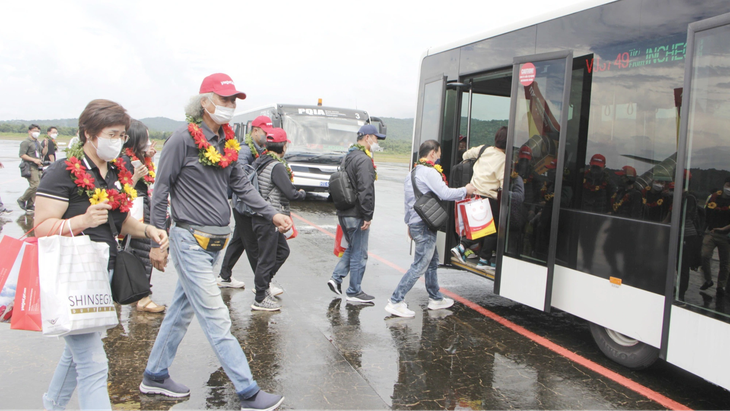Many airports in southern Vietnam are seeing a decline in passengers while the total count of passengers going through domestic airdromes rose 20 percent in the January-September period this year, according to the Civil Aviation Authority of Vietnam (CAAV).
Flights taking off and landing at Phu Quoc International Airport in Kien Giang Province, which is one of the busiest airports in the south, are not fully occupied.
The airport used to serve some 40 flights per normal day and 70-75 flights per day during the peak travel season.
However, the number has fallen to 26, or a 35-percent drop.
Between January 1 and October 13, nearly 27,400 flights taking off and landing at the airport, down a quarter compared with 2022 and meeting 60 percent of the full-year target.
During this year’s National Day holiday, from September 1 to 4, the island city welcomed over 62,500 passengers, falling 26.5 percent year on year.
The number of international air routes connecting to the city has gradually fallen. Only air routes to South Korea, Malaysia, and Thailand remain operational.
Can Tho International Airport in the namesake city has faced the same fate. It has failed to operate at its designed capacity of three million passengers per year.
In 2019, the airport serviced 10 domestic air routes and four international ones with 1.3 million passengers, or nearly half of its capacity, according to the Can Tho City Department of Transport.
After the COVID-19 pandemic was kept at bay, the department coordinated with the Department of Industry and Trade and the Department of Culture, Sports, and Tourism to launch some new air routes, including Can Tho-Quang Ninh.
However, the air route was effective during the pandemic only and is seeing few customers these days.
Nguyen Minh Tuan, director of the Can Tho Department of Culture, Sports, and Tourism, said the airport is operating eight domestic air routes. The average occupancy rate of flights reaches some 80 percent.
Meanwhile, Pham Thanh Lam, director of Ca Mau Airport in the namesake province, informed that the airport has operated only the Ca Mau-Ho Chi Minh City air route with a frequency of five flights per week.
The number of passengers on these flights is stable, at 80 percent of the seats on average.
The Ca Mau - Hanoi air route was opened on April 29 with three flights per week. It saw a high number of passengers but has been suspended since July 25 for the runway upgrade.
Seeking a way out
Director of the Kien Giang Province Department of Tourism Bui Quoc Thai said passengers traveling to Phu Quoc by air account for some 70 percent of the total visitors to the island.
He attributed the declining number of air passengers to unfavorable climate, the economic downturn, and airfare hikes.
The province will cooperate with the provincial tourism association to call on individuals and firms doing business in the tourism sector to improve products and services to meet tourists’ demands, Thai noted.
Quang Xuan Lua, director of the Kien Giang Tourism, Commerce, and Investment Promotion Center, said that tourism firms and airlines had been developing tourism promotion programs on Phu Quoc.
Meanwhile, director of the Can Tho Department of Culture, Sports, and Tourism Nguyen Minh Tuan said the department would join hands with some relevant units to hold a conference on the development of air routes between Can Tho and some key markets late this month.
“We have discussed the agenda of the conference with the Can Tho City Institute for Socio-Economic Development Studies and will invite airlines and the Can Tho International Airport authority to join,” Tuan noted.
Can Tho is executing some major projects, such as the Vietnam-Singapore Industrial Park and golf courses, which are expected to attract more visitors to the city, according to Nguyen Dang Khoa, deputy director of the Can Tho Department of Transport.
The completion of expressways in the coming time will pave the way for more people in the Mekong Delta to reach Can Tho, contributing to attracting more passengers for Can Tho International Airport, Khoa said.
The number of air passengers passing through Vietnam’s airports reached 89 million in January-September, up 20 percent year on year, according to the CAAV.
Of the total, domestic passengers inched down 3.6 percent to 65.3 million, while international passengers soared 266.8 percent to 23.7 million.
Local air carriers have expanded their international networks to improve revenue instead of focusing on the domestic market.
As a case in point, budget carrier Vietjet opened seven international air routes last quarter, increasing its air routes to 125, including 45 domestic routes and 80 international routes.
A representative of a Vietnamese air carrier told Tuoi Tre (Youth) newspaper that it often incurs losses on local air routes.
Therefore, it is hard to maintain regular flights to Can Tho Airport, Ca Mau Airport, and Rach Gia Airport in Kien Giang Province.
It is mainly focusing on Tan Son Nhat International Airport in Ho Chi Minh City, Da Nang International Airport in the namesake central city, Noi Bai International Airport in Hanoi, Cam Ranh Airport in south-central Khanh Hoa Province, and Dong Hoi Airport in north-central Quang Binh Province.
A CAAV representative said that the authority is managing 22 airports with only six of them reporting profits.
Like us on Facebook or follow us on Twitter to get the latest news about Vietnam!





















































